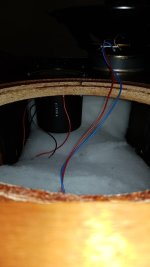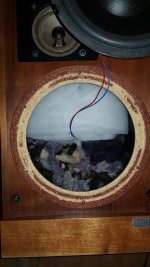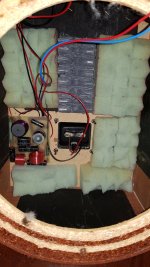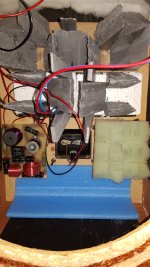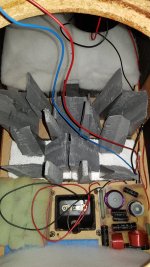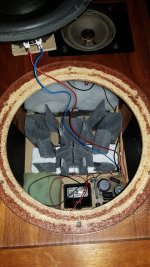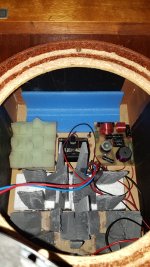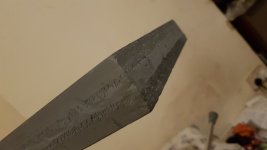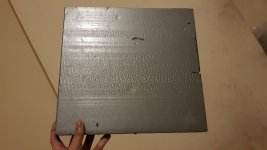So I have been thinking about the best way to damping my mission 720 speakers. These are a sealed enclosure 3way speaker. The tweeter is a closed back soft dome and the mid has it's own enclosure. On reading many threads and what I could find relating damping I tried the following.
1st was original damping which was 2 rolled up pollyfill material.
This killed the sound, over damping.
1st was original damping which was 2 rolled up pollyfill material.
This killed the sound, over damping.
Then I tried damping in the way of absorbing, so I used less pollyfill for the top end of the cab (woffer is in the lower end of cab) and wool behind and bottom of speaker. See picture. This I thought was good but listening tests proved not. Bass was deep and dense but not fast, midbass and upper bass was light and without definition.
Attachments
Damping is about absorbing the sound from the back of the woofer. It becomes most effective at frequencies above a few hundred Hz. With lots of damping material you can lower the Q of the low frequency resonance of the woofer and change the low frequency roll off, as if the woofer was in a larger box. That white plastic (Dacron / polyfil) damping material is the least effective as it is low density. I think you would benefit from making some measurements to see what effect it has. With less damping you will hear more box resonances coming back through the cone. Some people like that box sound. I do not. I heavily stuff my speaker boxes with dense fiberglass or lambs wool to absorb as much of the sound as possible. I don't want to hear the box. Measurement would show if the crossover is working properly and show what "killed the sound" means in terms of frequency range and dB lost. It could be the capacitor feeding the midrange is an electrolytic that is now half the value it was when new.
Last edited:
Thanks that all makes sense and I agree with the boxy boomy bass, I too dislike as do. The white stuff was originally what mission used. The picture has also wool that was directly behind the woffer which I thought would absorb the back wave but the result was abit better but still booming.
After more reading I tried foam that I had randomly shaped with pyramid type structure. The picture is f that with some white stuff also, I thought this may help to absorb and deflect. The result was better but lacking mid bass and definition.
After more reading I tried foam that I had randomly shaped with pyramid type structure. The picture is f that with some white stuff also, I thought this may help to absorb and deflect. The result was better but lacking mid bass and definition.
Attachments
Finally I went with deflecting waves directly behind the woffer with a dense polystyrene (cut in pointy shapes to reduce right angles) trying to resemble a anechoic chamber. Some white stuff up the top end of the speaker and abit at the base which I also placed dense foam in the base at the front and rear so to remove the right angles at the bottom of the speaker.
Attachments
Hi Bazza!
Your crossover still has black & red ELCAP electrolytic capacitors fitted whose values have almost certainly drifted over time.
The first step to improving the sound of your Missions is to replace those with modern non-polar (NP) electrolytic equivalents.
After that I suggest you fill the enclosures with this: https://www.woollyshepherd.co.uk/loudspeaker-wool/
Your crossover still has black & red ELCAP electrolytic capacitors fitted whose values have almost certainly drifted over time.
The first step to improving the sound of your Missions is to replace those with modern non-polar (NP) electrolytic equivalents.
After that I suggest you fill the enclosures with this: https://www.woollyshepherd.co.uk/loudspeaker-wool/
dense polystyrene
I suggest that the inclusion of polystyrene will only take up valuable enclosure space.
You want to absorb the higher frequency energy from the rear of the woofer, not reflect it.
So amazingly the above attempt was the best. A more defined and detailed bass and mid bass also. Even though the mid on the speaker has it's own enclosure it too was much more detailed. Remarkable success! I'm very happy with the results.
Thanks Galu, I have 2 pairs of the mission 720 to do and some others, my brother will help when he comes over from Sweden.Hi Bazza!
Your crossover still has black & red ELCAP electrolytic capacitors fitted whose values have almost certainly drifted over time.
The first step to improving the sound of your Missions is to replace those with modern non-polar (NP) electrolytic equivalents.
After that I suggest you fill the enclosures with this: https://www.woollyshepherd.co.uk/loudspeaker-wool/
This is the stuff, it's used for exterior home insulation.I suggest that the inclusion of polystyrene will only take up valuable enclosure space.
You want to absorb the higher frequency energy from the rear of the woofer, not reflect it.
Attachments
I got the idea from the b and w 302 speakersI suggest that the inclusion of polystyrene will only take up valuable enclosure space.
You want to absorb the higher frequency energy from the rear of the woofer, not reflect it.
This is the stuff, it's used for exterior home insulation.
Whatever the "stuff" is doing, I don't believe it's contributing to 'damping', the topic that your trials are about.
By definition: "Damping is a reduction in the amplitude of an oscillation as a result of energy being drained from the system to overcome frictional or other resistive forces".
The fibreglass wedges in anechoic chambers are designed to absorb sound. Any residual energy that is reflected lands on other wedges to undergo the same process again until all the energy is dissipated.
Your "stuff" looks more reflective than absorbent as far as sound is concerned. It might be a a good heat insulator, but that is of no consequence here.
Still, if you find its inclusion makes an improvement...
I got the idea from the b and w 302 speakers
The randomly arranged wedges at the rear of the enclosure are said to "resemble the walls of an anechoic chamber".
Note that the quote says "resemble" and not "act like" an anechoic chamber.
B&W's claim is that the arrangement helps eliminate standing waves inside the enclosure.
I presume it does so by randomising the reflections from the rear wall, which may be the effect you are benefiting from.
EDIT:
"The 302 is seemingly a simple two-way loudspeaker with a rectangular bass reflex port at the lower front. Internally it deviates from common practice by means of B&W's Prism technology: the back wall of the speaker enclosure is entirely covered with long plastic wedges. These break up standing wave patterns between the front and the back of the box, patterns that otherwise would emanate through the woofer cone and result in interference with the direct sound. Or in severe colourations, if you want. The Prism wedges are meant to be most effective in the critical range centered around 1-3 kHz, where the human ear is most sensitive."
https://www.tnt-audio.com/casse/bw302e.html
Last edited:
Exactly this," Prism technology: the back wall of the speaker enclosure is entirely covered with long plastic wedges. These break up standing wave patterns between the front and the back of the box, patterns that otherwise would emanate through the woofer cone and result in interference with the direct sound."
The lack of "interference" is the improved sound quality I'm getting. Honestly so much more details than before very impressive.
The lack of "interference" is the improved sound quality I'm getting. Honestly so much more details than before very impressive.
I feel I must add after listening, though many tracks sound so much better, on some I'm not hearing what I should...bass is totally missing?
I'm gonna give it one last effort to get it just how I want it. I will put the wool I have in between the pointy bits to absorb the rear waves behind the woffer. At the base I will also put wool and the top maybe a sandwich of the white original pollyfill with wool inside.
I'm just curious the changes make and bord. After the recap its going to be more serious, get everything properly air tight and better wirering.
Let's see part 4 I think
I'm gonna give it one last effort to get it just how I want it. I will put the wool I have in between the pointy bits to absorb the rear waves behind the woffer. At the base I will also put wool and the top maybe a sandwich of the white original pollyfill with wool inside.
I'm just curious the changes make and bord. After the recap its going to be more serious, get everything properly air tight and better wirering.
Let's see part 4 I think
Let's see part 4 I think
Here's your starter for Part 4, a closer look at the Mission 720 crossover board.
The capacitors are: 6 uF; 16 uF; 60 uF; (16 uF in parallel with 25 uF); 10 uF.
I can help you with selecting appropriate replacements.
Note that problems with the bass response may be due to the deterioration of the capacitor(s) associated with the woofer.
- Home
- Loudspeakers
- Multi-Way
- Speaker damping trials on sealed cabinet mission 720
